Campuses of Keio University
Keio University (慶應義塾) is the oldest and most highly rated private university[1][2][3][4][5][6][7][8][9][10] in Japan. Due to its age, its campuses have many historic buildings. This article introduces some of the school's notable architecture.
Mita campus[edit]
In 1858, Fukuzawa Yukichi founded the Rangaku-jyuku (蘭学塾, Western School). Ten years later the school's name changed to Keio Gijyuku (慶應義塾); in 1871 it moved to Mita, its main campus. The campus has a number of historic structures.
- Maboroshi no mon
- The former main gate,[11] the original black wooden gate dated to the Edo period. The present stone gate was built in 1913. In 2000, the gate was moved to top of a sloping stone walkway.[12]
- Mita Enzetsu kan (三田演説館, Mita Speech Hall)
- The original building was constructed in 1876. In 1947 the tile-roofed, two-story, Western-style wooden building was restored, and in 1967 it was designated an important cultural property.[13]
- Inari yama
- Inari yama is atop a flight of stone steps near the Speech Hall. Its name originated from the Inari-shi (稲荷祠, little Ynari shrine), built by the Shimabara clan, which was previously located there.[14] Although the shrine is gone, its name persisted after the university's founding.[15]
- Keio Gijyuku Toshokan kyūkan (慶應義塾図書館・旧館, Old Keio Gijyuku library)
- The old library and the Speech Hall are iconic campus buildings. The library was completed in 1912 as part of the university's 50th-anniversary celebrations. Designed by Sone Tatsuzō with his architectural partner Chujo Siichiro.[16] It includes the Fukuzawa Memorial Center of modern Japanese studies and the Institute of Oriental Classics (Shido Bunko).
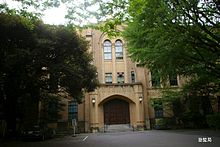
- Jukukan-kyoku (塾監局, Administration building)
- The campus administration building is known as Jyukukan-kyoku. Completed in 1926, it replaced a two-story brick building dating to 1886. Jyukukan-kyoku houses a number of departments, offices and meeting rooms.[17]
- New Minami kōsha (南校舎(新), South school building)
- Built in 2011, the new Minami kōsha was part of the university's 150th-anniversary celebration. Its design is similar in its modernism to the old Minami kōsha. The building has a mixture of lecture, study and multipurpose rooms.[18]

- Mita kōsha (南校舎(旧), Old school building)
- The old school building was constructed for the university's centenary in 1959. The 36-room building, with a capacity of 2,721, was the largest building on the Mita campus for many years.[19]
- Higashi kan (東館, East Research Building)
- Built in 2000, the East Research Building was designed like an old brick library. Near Maboroshi no mon, its arch features a quotation by Fukuzawa Yukichi in Latin: Homo nec ullas cuiquam praepositus nec subditus creatur ("Heaven does not make one man better or worse than others").[20] The Kuraiton Kafe (クライトンカフェ, Crichton cafe) is named for American writer and medical doctor Michael Crichton.[21]

- Minami bekkan (南別館, South Annex)
- The South Annex was built in 2009 to provide lecture space during the construction of the south building. The annex is headquarters for research coordination and administration, a research and administration center for the arts and a training room for the graduate school of human relations and the Institute of Cultural and Linguistic Studies.[22]
- Toshokan shin kan (図書館新館, New library)
- Designed by Fumihiko Maki, the new library was completed in 1982. The building has six stories above ground and five underground. Maki won the 1982 BCS prize[23] for his design.[24]
- Minami kan (南館, South Building)
- Built by Taisei Kensetsu in 2005, the seismically-isolated, reinforced-concrete South Building has eleven stories above ground and five underground. The building has classrooms, offices and training and counseling rooms.
- New Banraisha
- Banraisha is a social club for alumni, teachers and students. Designed by ja:Yoshiro Taniguchi and Isamu Noguchi, it was begun in 1946 to replace an 1887 building destroyed by American B-29 bombers in 1944 during the Pacific War. The Shin banraisha (新萬來舎, new Banraisha) was completed in 1951. In 2005, it (and its garden) was moved to the roof of the South Building.[25][26]

- Nishi kosha (西校舎, West Building)
- The West Building was constructed in 1959 (at the same time as the old Minami kōsha) as part of the university's centenary, on the site of the Dai kōdō (大講堂, main lecture hall) (which was destroyed in a 1945 aerial attack).[27]
- Graduate-school building
- The graduate-school building was constructed as part of the university's 125th anniversary. It houses classrooms, research rooms and offices.[28]
Other buildings include:
- Nishi-kan (西館, East Building): Keio University Athletic Association and Mita Bungaku offices, internal audit services
- Kita-kan (北館, North Building): Conference hall, health center and offices
- Daiichi Kōsha (第一校舎, Building One): Classrooms and offices
- Kenkyu-shitsu tō (研究室棟, Faculty Research Building): Offices, meeting and research rooms
- Keio University Press: International dormitory
Hiyoshi campus[edit]
The Hiyoshi campus opened in 1934. During World War II, some buildings were used by the Imperial Navy of Japan's (大日本帝國海軍, Dainihon teikoku kaigun) third region of naval operations (軍令部3部, Gunrei-bu san-bu) personnel division, engineering unit, headquarters of its combined squadron (連合艦隊司令, Rengō Kantai shirei-bu), naval command (海軍総隊司令部, Kaigun sōtai shirei-bu) and carrier air-wing command (航空本部, Kōkū honbu). Soon after its relocation the navy constructed a dugout, which remains. The campus still contains some undeveloped areas.[29] Its main road, 22 metres (72 ft) wide and 220 metres (720 ft) long (from Hiyoshi station to the Commemorative Hall, lined with 100 ginkgo trees), is a popular walking area. The tree-lined street received Dai anaka-kai Yokohama-shi Machinami Keikan-shō (第7回横浜市まちなみ景観賞, the seventh Yokohama Best Regional Landscape Award) in 1997.
Notable buildings include:
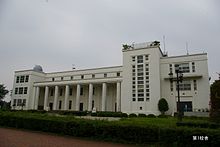
- Building One: Keiō Gijyuku high school building
- Building Two: The art-deco science-classroom building was designed by the Sone nakajyo architectural office (曾禰中條建築事務所, Sone-nakajyo-kentiku jimusho) and built by the Johen partnership (上遠合名会社, Jōen gōmei gaisha) and Shimizu Group (清水組, Shimizu gumi) in 1934.

- Kyosei-kan (協生館): Built in 2008 as part of the university's 150th-anniversary celebrations, its architecture is highly ranked by CASBEE Yokohama (横浜) (the Yokohama certification system for environmental friendliness). The complex features a pool, the graduate school and facilities available to the public.
- Raiōsha (来往舎): Designed and constructed by Shimizu Group in 2001, the seven-story building contains laboratories and reference libraries.

- Building Four (Independence Wing): Built in 2009 as part of the university's 150th-anniversary celebration by Kashima Group, the building features a communications studio.
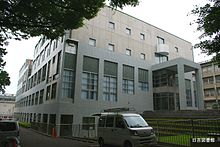
- Hiyoshi Library: Built with a ship motif in 1985, the library has 600,000 titles.

- Hiyoshi Commemorative Hall (記念館, Kinen kan): Built for the university's 100th anniversary in 1958, the hall's restructuring plans have been postponed.[30]
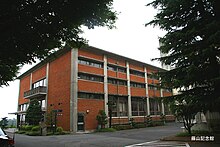
- Fujiwara Memorial Hall: Built in 1958 as a library with a donation from Aiichirō Fujiwara, it is now a multipurpose building.
- KBS: Opened in 1978, the former graduate school is vacant.
- Building Three: Classrooms, foreign-language lounge
- Building Four: Section A—classrooms; Section B—classrooms, counseling room, international and business centers
- Building Five: Built in 1962, the four-story building was demolished and replaced by a garden.
- Building Six: Classrooms, terrace
- Building Seven: Classrooms, lecture room, Hiyoshi information-technology center, computer room
- Building Eight: Classrooms, Psychology laboratory, art research room, musicology research department
Indoor fitness facilities[edit]
- Gymnasium: Judo and Kendo training rooms
- Sport ridge: Research laboratory, ping-pong training room
- Judo training room
- Sports medicine research center
Outdoor athletic plant[edit]
- Rugby field (birthplace of Japanese rugby)
- Equestrian facility
Public-health facility[edit]
- Health-management center
- Extracurricular-activity center
- Commons: Restaurants, assembly room, store
Accommodations[edit]
- Hiyoshi dormitory (日吉寄宿舎, Hiyoshi kishukusha): Designed by Yoshiro Taniguchi (1937)
- Shimoda Student Village (下田学生寮, Shimoda gakusei ryō): Four stories
- Baseball-club hostel (2008)
- KBS house
- Keio Nestle House
Other facilities[edit]
- Dugout entrance
- Yayoi period residence, with burial chamber
- Young Buddhists Association (佛教青年会館, Bukkyo seinen kaikan)
- YMCA chapel (1936)[31]
Shinanomachi campus[edit]
In 1917 a medical school (医学科予科, Igaku-ka yoka) opened in Mita, later moving to Shinanomachi and (during World War II) Musashino. Notable buildings include:
- New Building (新棟, Shin-tō): Built in 1987, the 11-story hospital has 1,056 beds.
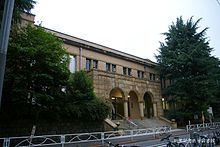
- Kitasato Memorial Medical Library: In 1937, the Dr. Kitasato Memorial Library Commission (北里博士記念医学図書館建設会, Kitasato hakushi kinen igaku tosho-kan kensetsu-kai) unveiled plans for a library in memory of the medical school's founder, Shibasaburo Kitazato. Three hundred thousand yen was raised, and 和田順顕 (Junkei Wada) was commissioned to design the building. In 1944 the commission donated the building to the university, and in 2004 it was renamed the Shinanomachi Media Center.[32] It has a large number of books, specializing in medical history. The Kitasato Prize (北里講堂, Kitasato kodo) is awarded annually.[33]

- Institute of Integrated Medical Research: The nine-story building was constructed in 2001.

- Clinical Research Building: The five-story building was constructed in February 2008.

- Preventive Medicine and Public Health Building: Built in 1929, the four-story building (designed by 曾禰中條建築事務所 (Sonenaka-jyo kenchiku jimusho) and built by 清水組 (Shimizu-gumi)) is the oldest on the Shinanomachi campus and until recently was used for lectures.
- Hospital annex: The annex was designed by Sone-naka-jyo kenchiku jimusho and constructed by 大林組 (Ōbayashi gumi) in 1932.[34] In 2008, it ended its operations; in November 2009, a ceremony to appease the earth・god (地鎮祭, Jichin sai) was held before the construction of Building 3.[35]
- Building 3: The six-story building has two wings: North (Clinical Research Building II) and South.
Clinic[edit]
- Central wing (1963)
- Wing 1 wards: Two outpatient wards (1965)
- Wing 2 wards: Clinical research wing (department of internal medicine)
- Wing 6 wards (1953)
- Wing 7 wards (1954)
- Outpatient rehabilitation center
- Endocrine center
- Advanced care center
- Radiographic diagnostic center
- Mortuary
Education and research[edit]
- East lecture hall (1957)
- Lecture Hall 2 (1961)
- Education and Research Building (1996): Lecture hall and seminar room
- Clinical Research Hall: Lecture theater
- Waksman Foundation of Japan (1957): Founded by 1952 Nobel laureate Selman Abraham Waksman for the Kitasato Saburo seitan Hyakunenn sai (北里柴三郎生誕百年祭, centennial celebration for Saburo Kisatato).[36]
- Kōyō-sha (孝養舎, Agape House): Nursing-school lecture room,[37] general-education center, gym
- Museum
- Animal housing
- Boiler room
Other buildings[edit]
- Brick Building (煉瓦館, Renga kan): The present commercial facility was built in 1995 on the site of the Human Diet Research Institute (食養研究所, Shokuyō kenkyu-jo).[38]
- 慶應稲荷大明神 (Keio Inari daimyo-jin): The Shinto shrine is located on campus.[38]
Yagami campus[edit]

- 創想館 (Sōsō kan): Built in 2000, the building has a basement reference room.[39]
Shonan Fujisawa campus[edit]
Shiba kyoritsu campus[edit]
In 2008 Keio University joined 共立薬科大学 (Kyoritsu Yakka daigaku) with campuses in Shiba and Urawa, opening its Department of Pharmacology and the Graduate School of Pharmaceutical Sciences. The campus has three buildings: 1, 2 and 3.[40]
Shin-kawasaki campus[edit]
The K2Town campus, built in 2000, aims to advance research and development among industry, academia and Kawasaki.[41]
Further reading[edit]
- 『慶應義塾七十五年史』 (1932) (in Japanese)
- 『慶應義塾百年史』 (1969) (in Japanese)
- Jyunichiro Isida (石田潤一郎), Akihisa Masuda (増田彰久) (1980) 『日本の建築 明治大正昭和7 ブルジョワジーの装飾』(Sanseido) (in Japanese)
- Keio Gijyuku University Mita information centor (慶應義塾大学三田情報センター編) (1972) 『慶應義塾図書館史』(慶應義塾大学三田情報センター) (in Japanese)
- 『慶應義塾史事典』 (2008) (in Japanese)
References[edit]
- ^ 2012世界大学学术排名 Archived 2012-08-17 at the Wayback MachineAcademic Ranking of World Universities by Shanghai Jiaotong University(written in Chinese)
- ^ THE-QS World University Rankings in 2012. QS Asian University Rankings overall in 2012
- ^ According to The Gourman Report (1997), in the medical field, Keio ranked seventeenth in the world, and in Japan headed the list.
- ^ According to International professional classification of higher education institutions by Théorie & Pratique (Mines Paris Tech), Keio was ranked 11th on The 377 leading higher education institutions in 2009.
- ^ By 世界大学科研竞争力排行榜2007 Archived 2010-01-11 at the Wayback Machine, Keio linked that Rank is 254th, and Total score is 30.58
- ^ ARWU2010 Archived 2010-08-22 at the Wayback Machine
- ^ Times Higher Education-QS World University Rankings 2009
- ^ Asian University Rankings | Top Universities
- ^ "MINES ParisTech - CLASSEMENT INTERNATIONAL PROFESSIONNEL". Archived from the original on 2012-01-05. Retrieved 2013-02-24.
- ^ About citation rate from 1999 to 2009 the Keio ranks thirteenth on a list of Thomson Reuters. The citation rate in material science area Keio ranks first from 2004 to 2008. In ISI-Thomson Scientific, the area of molecular biology, genetics, psychiatric medicine, humanity and social science of Keio made the top ten in 2002 – 2006. In highly oft-quoted papaers, area of neural science, clinical medicine, biology and biochemistry, Keio made the top seven. 国立情報学研究所・トムソンサイエンティフィック Archived 2012-01-25 at the Wayback Machine 調べ2009年 朝日新聞出版 (in Japanese)
- ^ 堀口大学『百年史』慶應義塾 (written in Japanese.)
- ^ 「慶應義塾豆百科No.81幻の門 慶應義塾大学(written in Japanese.)
- ^ [「慶應義塾草創時代の熱き弁舌がよみがえる 「演説」発祥の場所、「三田演説館」『塾』No.267 Summer 2010 (written in Japanese)]
- ^ In 1829 Daigo Shinsai (大郷信斎) reported gossip to that the old fox lives in the second mansion house of Shimabara clan through the years has a supernatural power in Doucho Rusetsu Vol. 19 (『道聴塗説』第19編).
- ^ [慶應義塾豆百科] No.32 稲荷山(慶應義塾) (in Japanese)
- ^ 「ステンドグラス 慶應義塾図書館開館100年 一世紀にわたり親しまれる、義塾のシンボル」『塾』No.274 2012年SPRING (written in Japanese)
- ^ 塾監局 (in Japanese)
- ^ 慶應義塾大学三田南館de'-TAISEI DESIGN (in Japanese)
- ^ 記憶の南校舎 - 慶應義塾福沢研究センター - Keio University (in Japanese)
- ^ 「東館アーケード入り口」三田キャンパスギャラリー (in Japanese)
- ^ 「塾内NEWS」2000 WINTER(No.227)(written in Japanese)
- ^ 南別館の竣工(三田キャンパス)(慶應義塾) (in Japanese)
- ^ "日本建設業連合会(BCS賞)". Archived from the original on 2013-02-07. Retrieved 2013-02-24.
- ^ 三田メディアセンター - 慶應義塾大学メディアセンター(written in Japanese)
- ^ 慶応義塾三田キャンパスの建物 (明治安田生命友和会) (written in Japanese)
- ^ 「萬來舎」の歴史(written in Japanese)
- ^ "三田キャンパスマップ(慶應義塾)" (PDF). Archived from the original (PDF) on 2015-11-29. Retrieved 2014-01-07.
- ^ "慶應義塾大学 三田キャンパス" (PDF). Archived from the original (PDF) on 2013-10-27. Retrieved 2014-02-09.
- ^ 慶應義塾「キャンパスを飾る樹木」 (in Japanese)
- ^ 『慶應塾生新聞』第449号
- ^ "Archived copy". www2s.biglobe.ne.jp. Archived from the original on 20 June 2013. Retrieved 14 January 2022.
{{cite web}}: CS1 maint: archived copy as title (link) - ^ 慶應義塾大学信濃町メディアセンター Archived 2012-12-26 at the Wayback Machine(written in Japanese)
- ^ THE KEIO MEDICAL SCIENCE PRIZ
- ^ 『慶應義塾医学部新聞』第696号 (in Japanese)
- ^ 『慶應義塾医学部新聞』第696号 (written in Japanese)
- ^ 公益財団法人 日本ワックスマン財団(written in Japanese)
- ^ Keio University Faculty of Nursing and Medical Care
- ^ a b 『慶應義塾史事典』2008年(平成12年)
- ^ Keio University Science and Technology
- ^ KEIO UNIVERSITY FACULTY OF PHARMACY
- ^ 慶應義塾大学新川崎K2タウンキャンパス 新川崎先端研究教育スクエア (in Japanese)
External links[edit]
